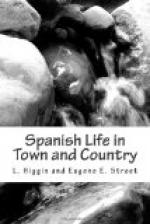If the money no longer being expended in railways and docks were now devoted to irrigation wherever it is needed, a rapid change would become apparent over the whole face of the country, and the population would increase in proportion as the land would bear it. Irrigation works have been more than once undertaken by the aid of foreign money, and under the charge of foreign engineers; but the people themselves—the landowners and peasant proprietors—were not ripe for it, and, alas! some of the canals which would have turned whole valleys into gardens have been allowed to go to ruin, or to become actually obliterated, while the scanty crops are raised once in two or three years from the same soil, which will yield three crops in one year by the help of water. Difficulties arose about the sale of the water—a prolific cause of dispute even in the old irrigated districts—and the people said: “What do we want with water, except what comes from heaven? If the Virgin thinks we want water, she sends it.” Fitting result of the teaching of the Church for so many years, with the example ever held up for admiration of the patron saint, Isidro, who knelt all day at his prayers, and left the tilling of his fields to the angels! It would seem that these ministers of grace are not good husbandmen, since the land became the arid waste it now is, while successive Isidros have been engaged in religious duties, which they were taught were all that was necessary.
As an example of what irrigation means in the sunlit fields of Spain, an acre of irrigable land in Valencia or Murcia sells for prices varying from L150 to L400, according to its quality or its situation, while land not irrigable only fetches sums varying from L7 to L20. In Castile, land would not in any case fetch so high a price as that which has been under irrigated cultivation for centuries past; but in any district the value of dry land is never more than a twelfth of what it is when irrigable. In truth, however, there is more than irrigation needed to bring the lands of Castile and Estremadura into profitable cultivation, and it cannot be done without the expenditure of large sums of money at the outset in manures, and good implements in place of the obsolete old implements with which the ground is now scratched rather than ploughed. Given good capital and intelligent farming, as in the irrigated districts, and two, and even three, crops a year can be raised in unceasing succession; lucern gives from ten to twelve cuttings in one year, fifteen days being sufficient for the growth of a new crop.
I have pointed out what one day’s sun can do in raising grass seed in Madrid, which stands on the highest point of the elevated table-land occupying the centre of Spain. Seeing that the principal item of the revenue is derived from the land tax, and that it is calculated on the value of the land, it would appear to be the first interest of an enlightened government to foster irrigation in every possible way, and encourage agriculture and the planting of trees.




